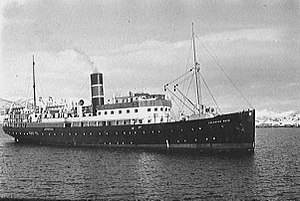SS Dronning Maud (1925)

Dronning Maud in 1936
|
|
| History | |
|---|---|
|
|
|
| Name: | SS Dronning Maud |
| Namesake: | Queen Maud of Norway |
| Owner: | Det Nordenfjeldske Dampskipsselskap |
| Port of registry: | Trondheim |
| Route: | Hurtigruten |
| Ordered: | June 1924 |
| Builder: | Fredrikstad Mekaniske Verksted |
| Cost: | 2,000,000 kr |
| Yard number: | 246 |
| Launched: | 8 May 1925 |
| Christened: | 30 June 1925 |
| Commissioned: | 3 July 1925 |
| Maiden voyage: | 30 June 1925 |
| In service: | 13 July 1925 |
| Out of service: | 1 May 1940 |
| Identification: |
|
| Fate: | Sunk by German aircraft |
| General characteristics | |
| Type: |
|
| Tonnage: | 1,489 gross register tons (GRT) |
| Length: | 235 ft (71.63 m) |
| Beam: | 11.5 ft (3.51 m) |
| Propulsion: | 1,500 hp triple expansion steam engine |
| Speed: |
|
| Capacity: | 400 passengers (1925) |
| Armament: |
|
Coordinates: 68°41.917′N 017°26.367′E / 68.698617°N 17.439450°E
SS Dronning Maud was a 1,489 ton steel-hulled steamship built in 1925 by the Norwegian shipyard Fredrikstad Mekaniske Verksted in Fredrikstad.Dronning Maud was ordered by the Trondheim-based company Det Nordenfjeldske Dampskipsselskap for the passenger and freight service Hurtigruten along the coast of Norway. She served this route as the company flagship until she was sunk under controversial circumstances during the 1940 Norwegian Campaign.
Dronning Maud was ordered from Fredrikstad Mekaniske Verksted shortly after the loss of Det Nordenfjeldske Dampskipsselskap's Haakon Jarl.Haakon Jarl had suffered a collision with fellow Nordenfjeldske ship Kong Harald in the Vestfjord on 17 June 1924, sinking with the loss of 12 passengers and seven crew members. The building order of Dronning Maud made her the first new ship to join the Hurtigruten route since Finmarken in 1912. After her 8 May 1925 launch she had her first test run in the Oslofjord on 30 June 1925 and was formally handed over to Nordenfjeldske on 3 July. Nordenfjeldske immediately sent her northwards to Trondheim from where she joined the northbound Hurtigruten service, sailing from Brattøra at 12:00 on 13 July.
With the construction of Dronning Maud a new concept was introduced to the Hurtigruten ships, with the First Class section moved forward to amidships and the Second Class removed altogether in order to make room for a greatly improved Third Class in the aft section. The salons and cabins in the Third Class area on board Dronning Maud were described at the time as both "light and practical". Her outer appearance was characterized by long, clean lines, a large superstructure and a long continuous promenade deck. She was considered a very seaworthy vessel and in 1931 became the first Hurtigruten ship to be equipped with the new safety feature of wireless telegraphy. By 1936 all the Hurtigruten ships had been equipped with the new technology.
...
Wikipedia
